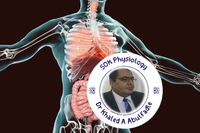admin
Admin

عدد المساهمات : 9696
تاريخ التسجيل : 06/08/2009
 |  موضوع: Dr Khaled Abulfadle master degree thesis role of l-arginine-nitric oxide in urinary bladder contractility موضوع: Dr Khaled Abulfadle master degree thesis role of l-arginine-nitric oxide in urinary bladder contractility  الثلاثاء نوفمبر 09, 2010 5:30 am الثلاثاء نوفمبر 09, 2010 5:30 am | |
| INTRODUCTION AND AIM OF WORK
Bladder outlet obstruction (BOO) is one of the most common urological problems in elderly men (McGuire, 1984; Berggren and Uvelius, 1998).
Bladder outlet obstruction secondary to benign prostatic hyperplasia (BPH) induces various bladder dysfunctions. Increases in urinary frequency and urgency are typical signs of the early stages of BPH (McGuire, 1984).
During the later stages of BPH, patients suffer from increasing amounts of residual urine and are subject to overflow incontinence due to retention (McGuire, 1984).
These symptoms may be related to the lack of ability of the detrusor to compensate for bladder outlet obstruction and result in impaired detrusor contractility (Saito et al., 1993). But the association between bladder outlet obstruction and the resulting changes in bladder function is poorly understood (Greenland and Brading, 2001).
In an animal model, bladder weight was significantly increased (Saito et al., 1993a; Berggren and Uvelius, 1998 and Kim et al., 2000), and contractile response was significantly decreased by BOO.
The pathological progression of untreated bladder outlet obstruction has been explained clinically by the concept of a detrusor muscle compensatory response. This concept assumes that in response to obstruction, the bladder smooth muscle hypertrophies to produce the elevated pressures necessary to maintain effective emptying (Gosling et al., 2000 and Stein et al., 2001).
However, if the obstruction is left untreated, the bladder becomes dysfunctional, leading to a significant loss of contractile ability and an increase in postvoid residual volume. This is presumably due to an imbalance between the passive and active mechanical properties of the detrusor muscle and the magnitude of the resistance to flow. Removal of the obstruction before a state of severe dysfunction reverses the hypertrophic response, and normal function may be regained (Gosling et al., 2000 and Stein et al., 2001).
In general, results from studies using animal models of bladder outlet obstruction report rapid and marked morphological and functional changes in the detrusor muscle, similar to those reported in human clinical studies (Sibley, 1985 and Ghonieum et al., 1986). The majority of these animal studies report a decrease in several parameters of detrusor contractility.
In recent years, some authors have reported that increased intravesical pressure and bladder outlet obstruction are associated with decreased bladder blood flow (Nielsen, 1995; Greenland and Brading, 1996; Lin et al., 1998). Nielsen (1995) showed that a median decrease of 47% in blood flow rate was observed after distension in the 2 month obstructed mini-pig bladder.
After 2 weeks of partial bladder outlet obstruction in rabbits, Lin et al. (1998) reported an 80% decrease in blood flow rate. Also, Greenland and Brading (2001) showed that significant detrusor ischemia occurs during prolonged voiding contractions in obstructed pigs.
Nitric oxide (NO) mediates relaxation of smooth muscle. Until recently, there have been few reports of this type of relaxation in the detrusor smooth muscle. Andersson and Persson (1995) have described that the detrusor had a lower sensitivity to NO, which makes it less likely that it can play the role of a relaxant neurotransmitter. Moreover, NO is a major blood flow regulator that is synthesized and released by NO synthase (NOS).
Although there have been no reports on measurement of NO in the obstructed bladder, there has been speculation regarding the role of NO in bladder ischemia of the obstructed bladder (Sutherland et al., 1998).
Some authors have reported that detrusor mitochondrial damage may explain voiding dysfunction after BOO (Lu et al., 2000). Other reports have found that BOO induces reduction in blood flow (ischemia), and that ischemia caused by BOO induces bladder dysfunction (Lin et al., 1995; Buttyan et al., 1997).
Several studies have revealed that nitric oxide (NO) is an important neurotransmitter and intracellular messenger that promotes homeostasis in many tissues (Saito and Miyagawa, 1999).
One of the most important effects of NO is reported to be its role as a neurotransmitter in non-adrenergic non-cholinergic nerves, and the L-arginine-NO pathway has been shown to play a role in muscle relaxation and vasodilation (Arthur and Burnett, 1995).
NO stimulates the formation of guanylate cyclase in smooth muscle cells, converting GTP to 3' 5'-cyclic GMP (cGMP) (Burnett, 1997). A cascade of cGMP-dependent intracellular events then leads to a decrease in intracellular calcium, ultimately causing smooth muscle relaxation and vasodilation, in part through changes in potassium conductance (Seftel et al., 1996; Burnett, 1997).
It has been reported that NO is induced by ischemia injury (Saito and Miyagawa, 1999), and that NO synthase (NOS) isoform activity, that is, inducible NOS (iNOS) activity, was decreased in long-term obstruction for 5 weeks (Lemack et al., 1999).
On the other hand, some found that NOS activity did not show significant changes in short-term obstruction (Shabsigh et al., 2000).
In this study, we investigated the effect of NO on normal bladder and also on bladder dysfunction caused by BOO with organ bath techniques and to determine whether L-arginine, a precursor of NO synthesis, prevents bladder dysfunction induced by bladder outlet obstruction or not.
to download full thesis press this link
dr khaled
or
dr khaled A Abulfadle
       | |
|
